
If you’ve ever wanted to add captivating animations to your PowerPoint slides but didn’t know where to start, or if you dreamed of creating truly unique and advanced animations but felt stuck, you’re in the perfect place. PowerPoint animations can transform a plain presentation into a dynamic storytelling experience that engages your audience and leaves a lasting impression.
My name is Kaspare, also known as One Skill on YouTube, and I’ve been passionate about helping millions of people create awesome PowerPoint presentations for nearly a decade. Today, I’m excited to guide you through the essential knowledge and tips to master PowerPoint animations — from the basics to advanced techniques — so you can create animations that wow your audience every time.
In this comprehensive guide, you’ll learn everything you need to know to become a PowerPoint animation pro. Whether you’re a beginner or an experienced user, this article will walk you through the fundamentals, explore different animation types, and reveal powerful tricks to take your slides to the next level.

Table of Contents
- Why PowerPoint Animations Matter
- The Four Main Types of PowerPoint Animations
- How to Add Animations in PowerPoint
- Advanced Animation Tips and Tricks
- Four More Ways to Animate in PowerPoint
- Creating Custom Animations with Multiple Effects
- Adding Smoothness to Your Animations
- Frequently Asked Questions About PowerPoint Animations
- Conclusion: Start Creating Incredible PowerPoint Animations Today
Why PowerPoint Animations Matter
Animations aren’t just flashy effects; they are powerful tools to enhance your presentation’s storytelling, highlight key points, and maintain audience engagement. With well-crafted animations, you can:
- Introduce content smoothly: Bring in text, images, or videos with style.
- Emphasize important information: Draw attention to specific data or ideas.
- Control pacing: Manage the flow of your presentation by timing animations with your speech.
- Make complex data easier to understand: Use animated infographics to visually guide your audience.
- Add professionalism and polish: Well-executed animations show effort and mastery.
Whether you’re a designer, business professional, entrepreneur, instructor, speaker, teacher, or student, mastering PowerPoint animations will elevate your presentations and make your message stand out.
The Four Main Types of PowerPoint Animations
Before diving into how to animate your slides, it’s important to understand the four main categories of animations in PowerPoint:
| Animation Type | Description | Common Uses |
|---|---|---|
| Entrance Animations | Animations that bring objects onto the slide. | Introducing text, images, videos, or shapes to your slide. |
| Emphasis Animations | Animations that highlight or draw attention to objects already on the slide. | Spinning, pulsing, or changing color of an object to emphasize it. |
| Exit Animations | Animations that make objects leave the slide or disappear. | Hiding or removing content after it’s no longer needed. |
| Motion Path Animations | Animations that move objects along a defined path on the slide. | Moving objects in custom patterns like lines, circles, or complex shapes. |
Each type serves a unique purpose in storytelling and can be combined creatively to produce stunning effects.
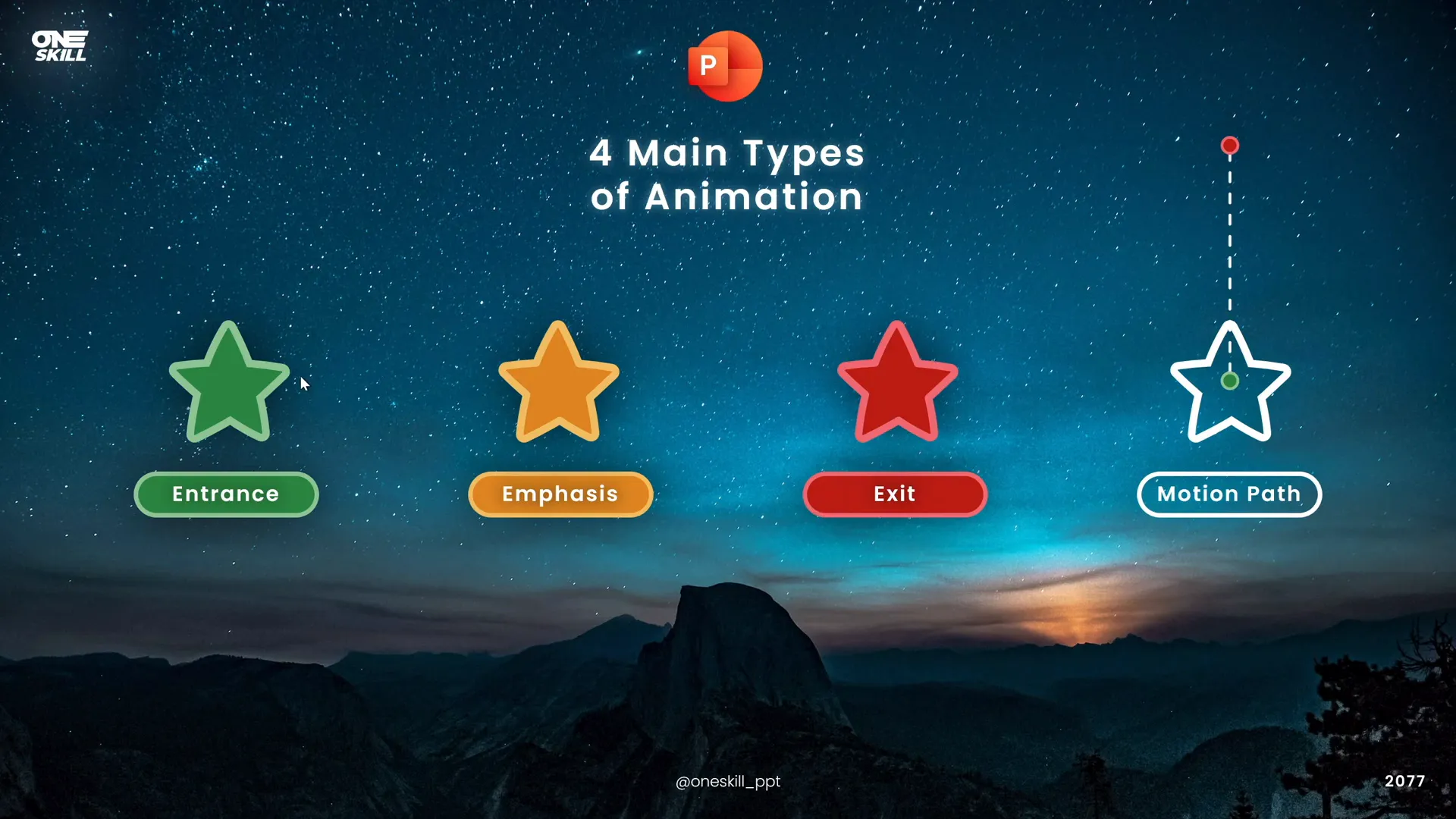
Entrance Animations
Entrance animations are perfect when you want to introduce something new to your slide. Whether it’s a picture, a block of text, or a video clip, entrance animations help smoothly bring that content to life. Examples include:
- Fly In: Object flies in from a direction.
- Fade: Object gradually appears.
- Zoom: Object grows into view.
Emphasis Animations
Once your object is on the slide, you might want to highlight it to keep your audience focused. Emphasis animations add dynamic effects like spinning, pulsing, or changing color to make objects stand out.
Exit Animations
When an object’s role in your presentation is done, exit animations help you remove it gracefully, avoiding clutter and maintaining focus on the current content.
Motion Path Animations
Motion path animations allow you to define custom paths for objects to follow, whether moving in a straight line, a circle, or a custom shape. This is a powerful tool for storytelling and illustrating processes or journeys.
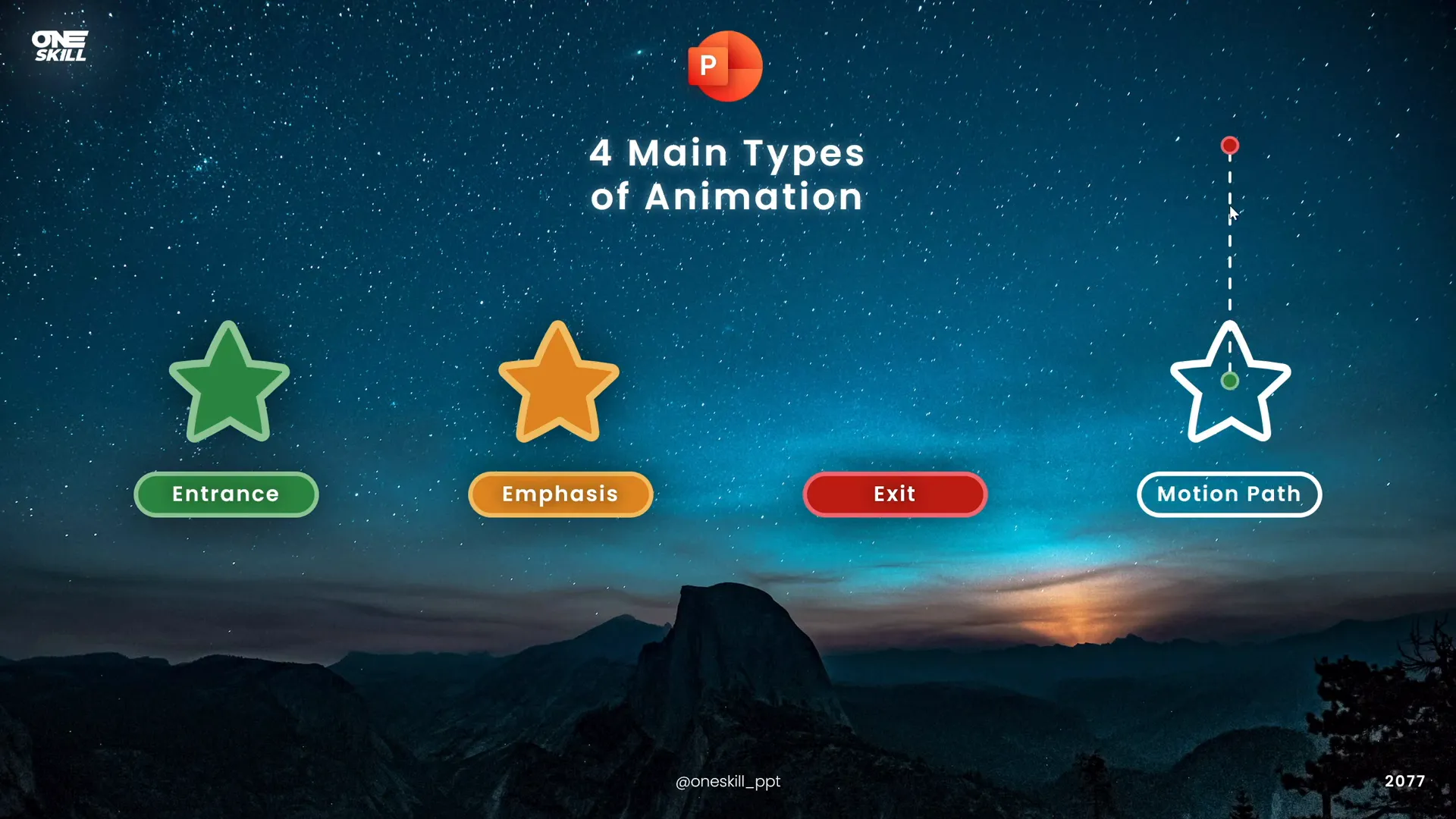
How to Add Animations in PowerPoint
Adding animations in PowerPoint is easier than you might think. You can animate virtually any element on your slide — shapes, text boxes, pictures, videos, and even 3D models. Here’s a step-by-step guide:
Step 1: Select Your Object
Click the object you want to animate. This could be a shape, a text box, or an image.
Step 2: Open the Animations Tab
Navigate to the Animations tab in the PowerPoint ribbon. You’ll see a selection of animation thumbnails.
Step 3: Choose an Animation
Click any animation to apply it to your selected object. You can preview animations by hovering over them or clicking them. If you want more options, click the small arrow at the bottom right of the animation gallery to see the full list categorized into Entrance, Emphasis, Exit, and Motion Paths.
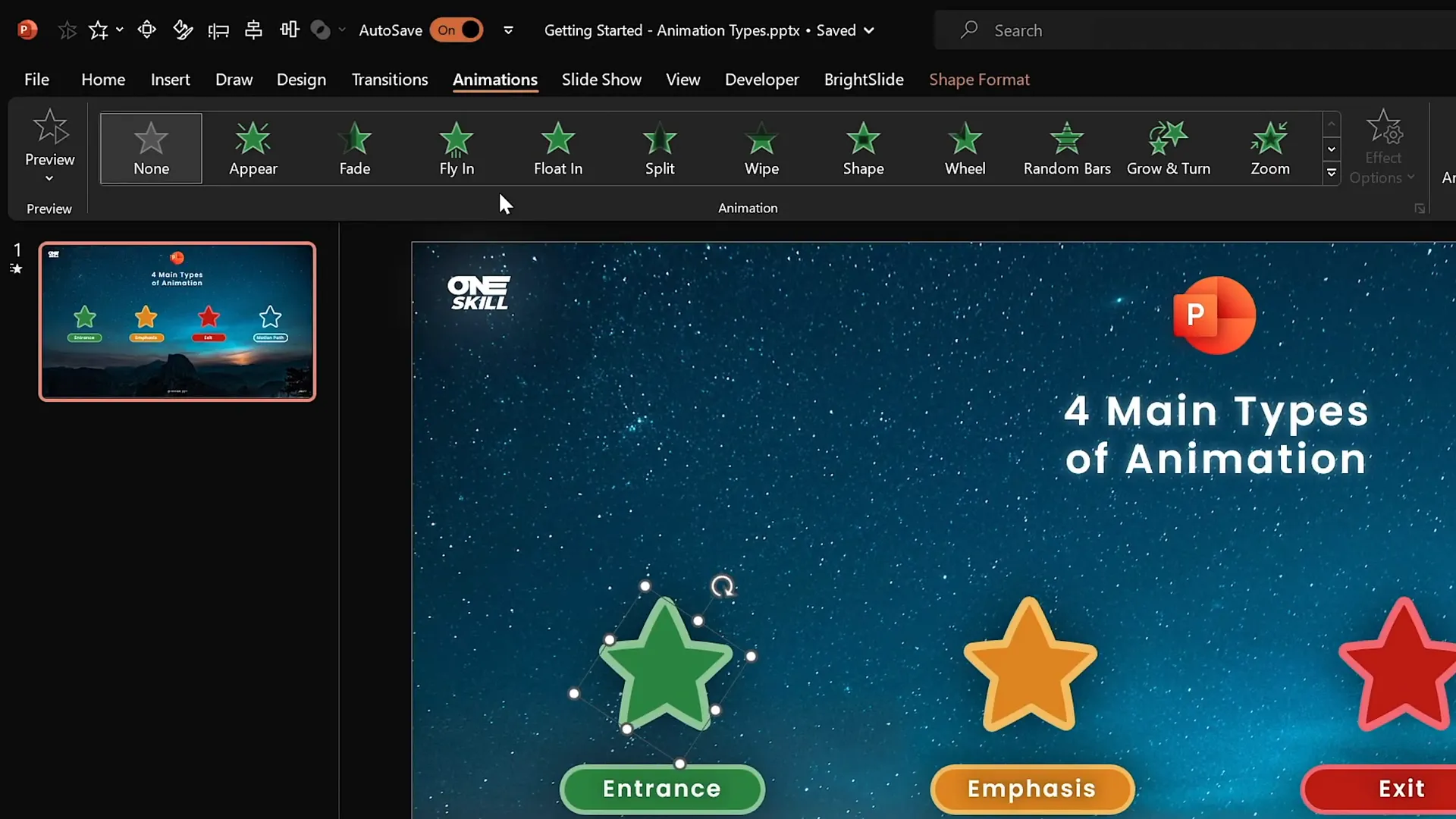
Step 4: Customize Your Animation
Most animations come with additional options. For example, the Fly In animation lets you choose the direction from which the object flies in (left, right, top, bottom).
Step 5: Add Multiple Animations
If you want to add more than one animation to the same object, use the Add Animation button instead of clicking a new animation directly. This ensures the new animation is added rather than replacing the existing one.
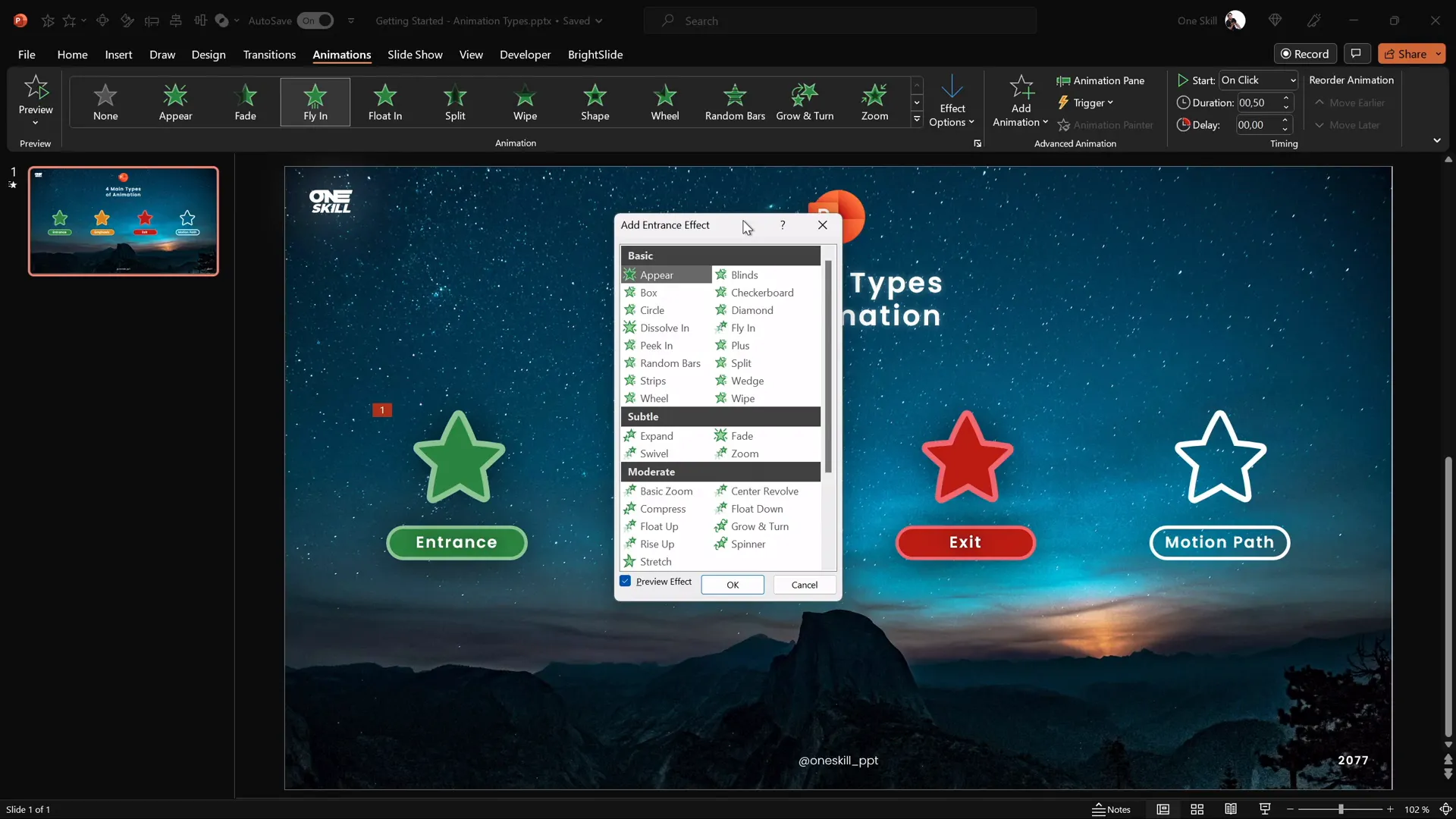
Step 6: Use the Animation Pane
The Animation Pane is your control center for managing animations on a slide. Open it from the Animations tab to see all animations applied, their order, timing, and effects. You can adjust when each animation starts:
- On Click: Animation starts when you click.
- With Previous: Animation starts simultaneously with the previous one.
- After Previous: Animation starts right after the previous one ends.
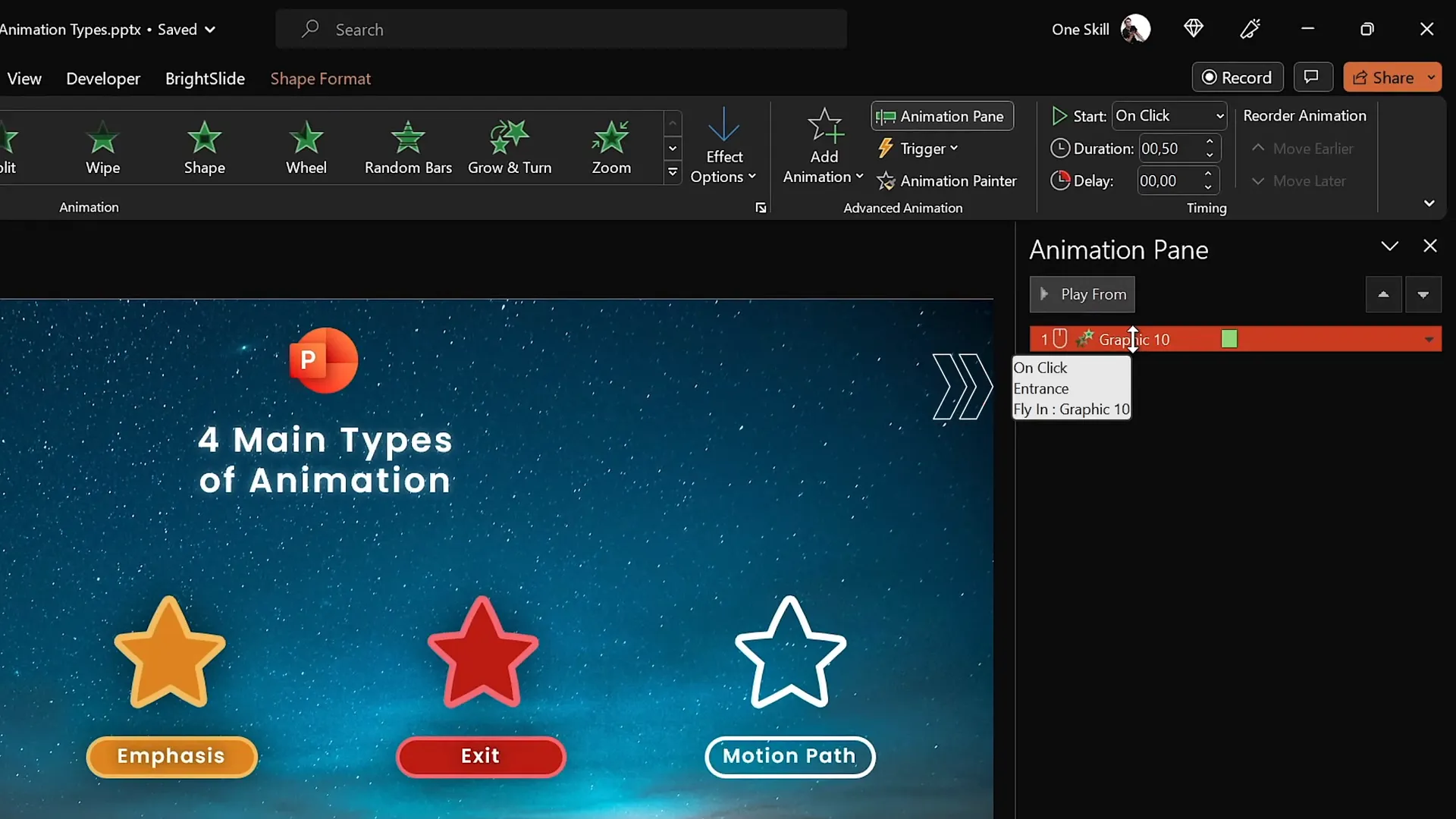
Step 7: Preview Your Animations
Use the Play From button in the Animation Pane to preview how your animations will play during the presentation. This helps you fine-tune timing and transitions.
Advanced Animation Tips and Tricks
Popular Animations by Category
Based on years of experience, here are some of the most commonly used animations from each category:
| Category | Recommended Animations | Use Cases |
|---|---|---|
| Basic | Fly In | Introducing objects smoothly |
| Subtle | Fade, Zoom | Gentle transitions and emphasis |
| Moderate | Basic Zoom, Float Down | Dynamic content introduction |
| Exciting | Pinwheel | Introducing photos or eye-catching content (use sparingly) |
Tip: Avoid overusing exciting animations. They can be distracting if applied too often.
Adding Multiple Animations to One Object
Want to make your animations more dynamic? Add multiple effects to the same object! For example, you can have a shape fly in and then spin. Just remember to use the Add Animation button to add each new effect instead of replacing the existing one.
Adjusting Animation Timing
Control the speed and sequence of your animations for maximum impact:

- Use the Animation Pane to set the duration of each animation.
- Adjust delay times to stagger animations smoothly.
- Choose whether animations start on click or automatically.
Four More Ways to Animate in PowerPoint
PowerPoint offers even more animation possibilities beyond the four main types. Here are four additional powerful ways to animate your slides:
1. Text Animations
Text animations belong to the emphasis category and are specifically designed for text elements. You can animate text color changes, waves, or other effects that bring your words to life. This is ideal for making headlines or bullet points more engaging.

2. Draw Animations
If your version of PowerPoint supports the Draw feature, you can create custom hand-drawn animations. Use pens or pencils to draw shapes or lines, then animate them with Replay or Rewind effects to simulate drawing or erasing on screen. This adds a personal touch and can be great for illustrating concepts live.
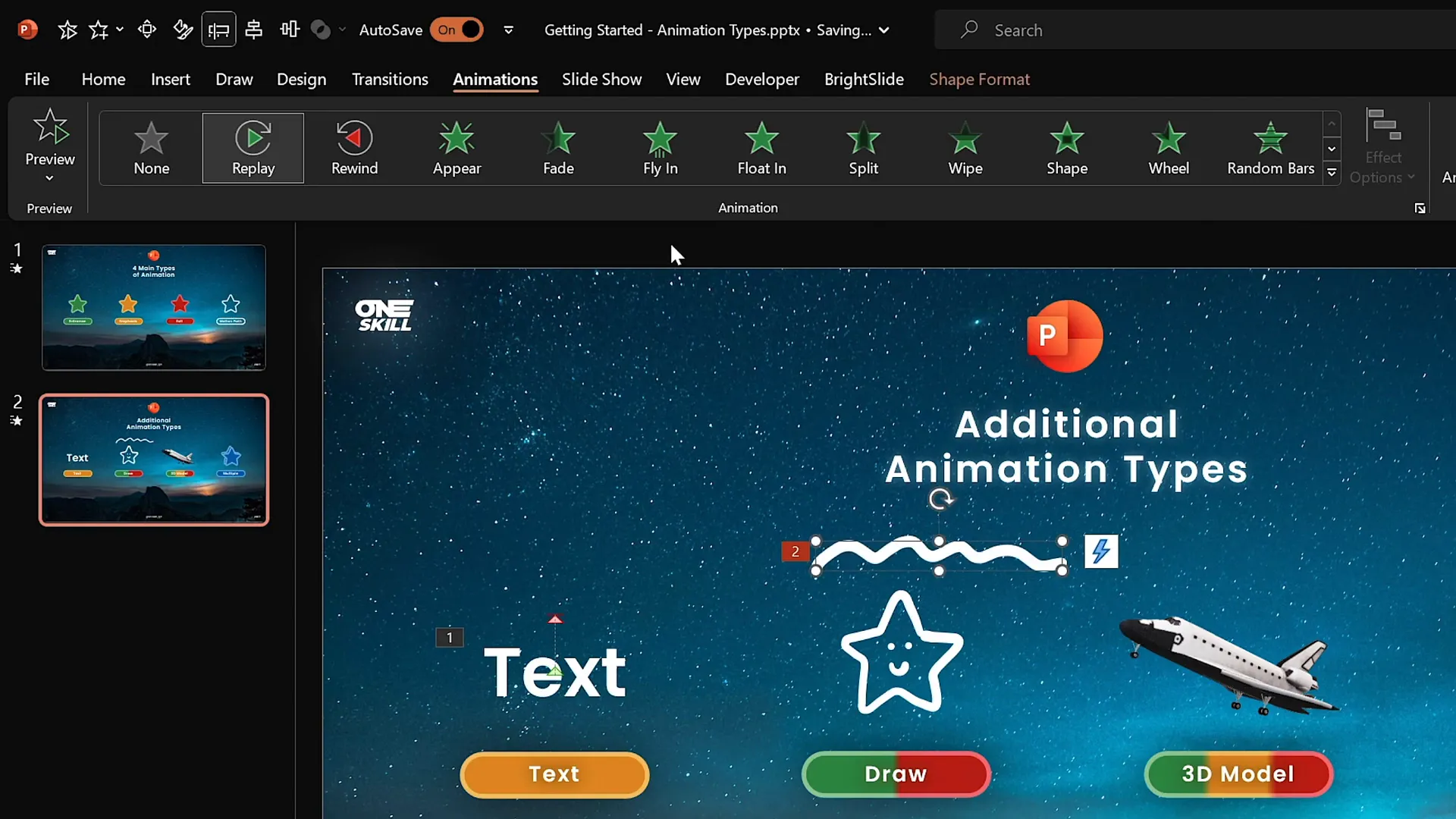
3. 3D Model Animations
PowerPoint supports 3D models, which you can animate with entrance, emphasis, and exit effects tailored specifically for 3D content. For example, a 3D space shuttle can spin slowly or zoom in, adding depth and visual interest to your presentation.
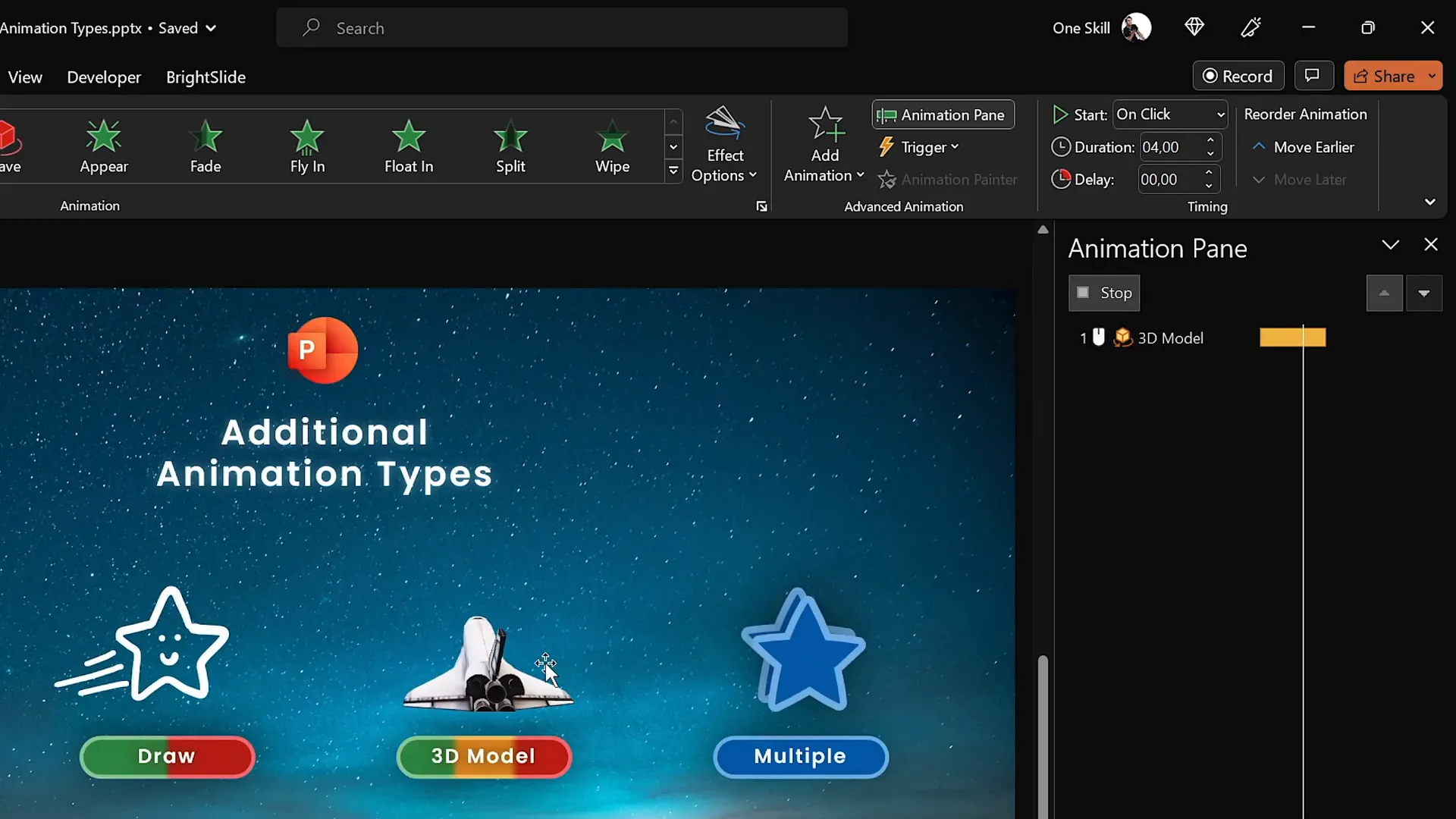
4. Multiple Animations
Combine multiple animations on a single object to create complex, custom animations. For instance, you can have a shape follow a motion path while spinning simultaneously. This technique allows for creative storytelling and eye-catching effects.
Creating Custom Animations with Multiple Effects
Let’s look at an example of creating a custom animation using multiple effects:
- Select the object or group of objects you want to animate.
- Add a motion path animation to move the object along a line or custom path.
- Activate the Auto Reverse option in the animation settings to make the object return to its starting point automatically.
- Add a spin animation to the same object using the Add Animation button.
- Set the spin animation to start With Previous so it runs simultaneously with the motion path.
- Adjust the duration of both animations so they start and finish together.
This technique can be used to create smooth, professional-looking animations that impress your audience.
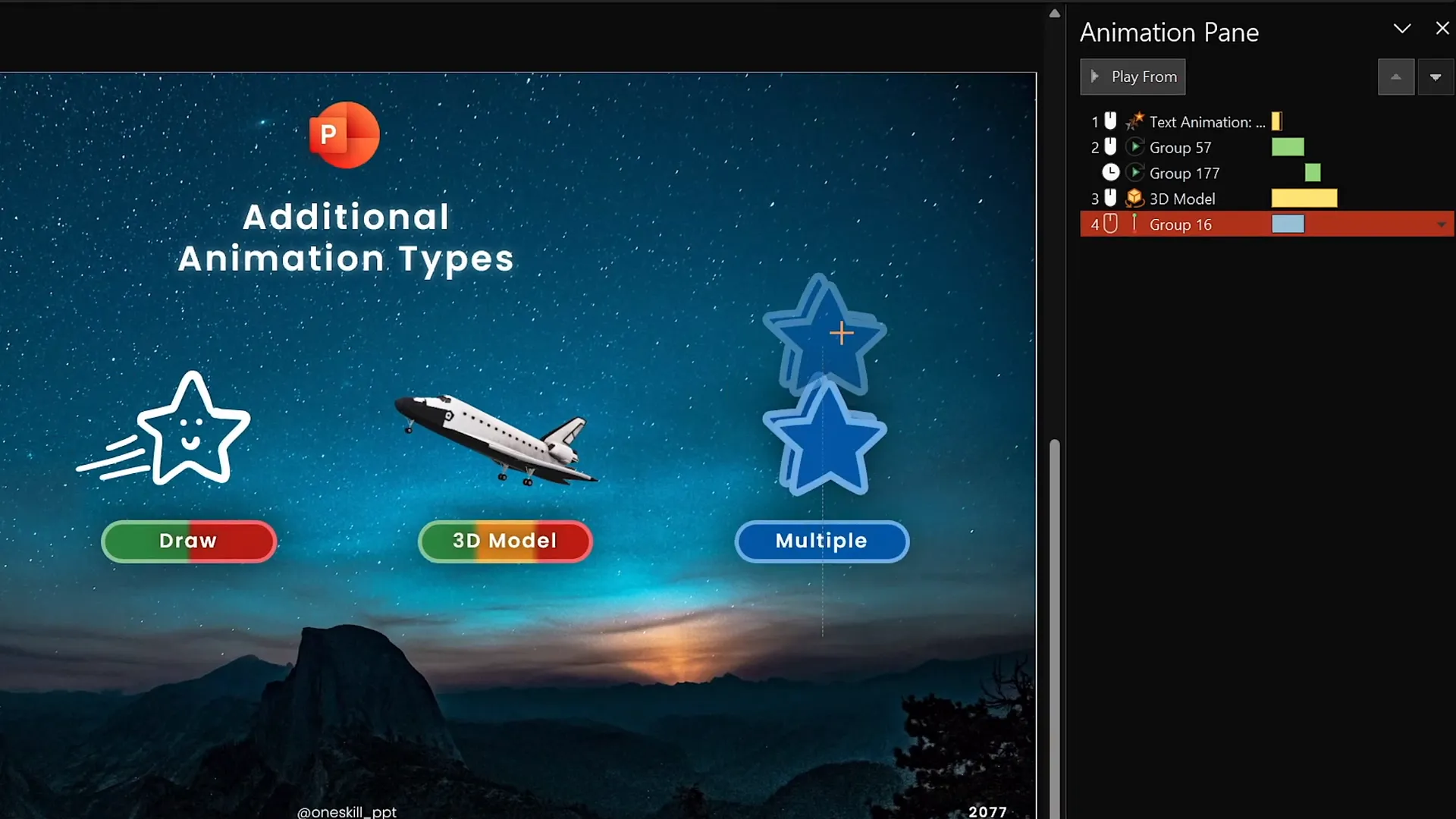
Adding Smoothness to Your Animations
Animation smoothing is a subtle but powerful way to make your animations look polished and professional. By adjusting the Smooth Start and Smooth End sliders in the animation options, you can make movements more natural and less abrupt.
For example, applying maximum smoothness to a motion path and spin animation makes the object ease into and out of the animation gracefully, enhancing viewer experience.
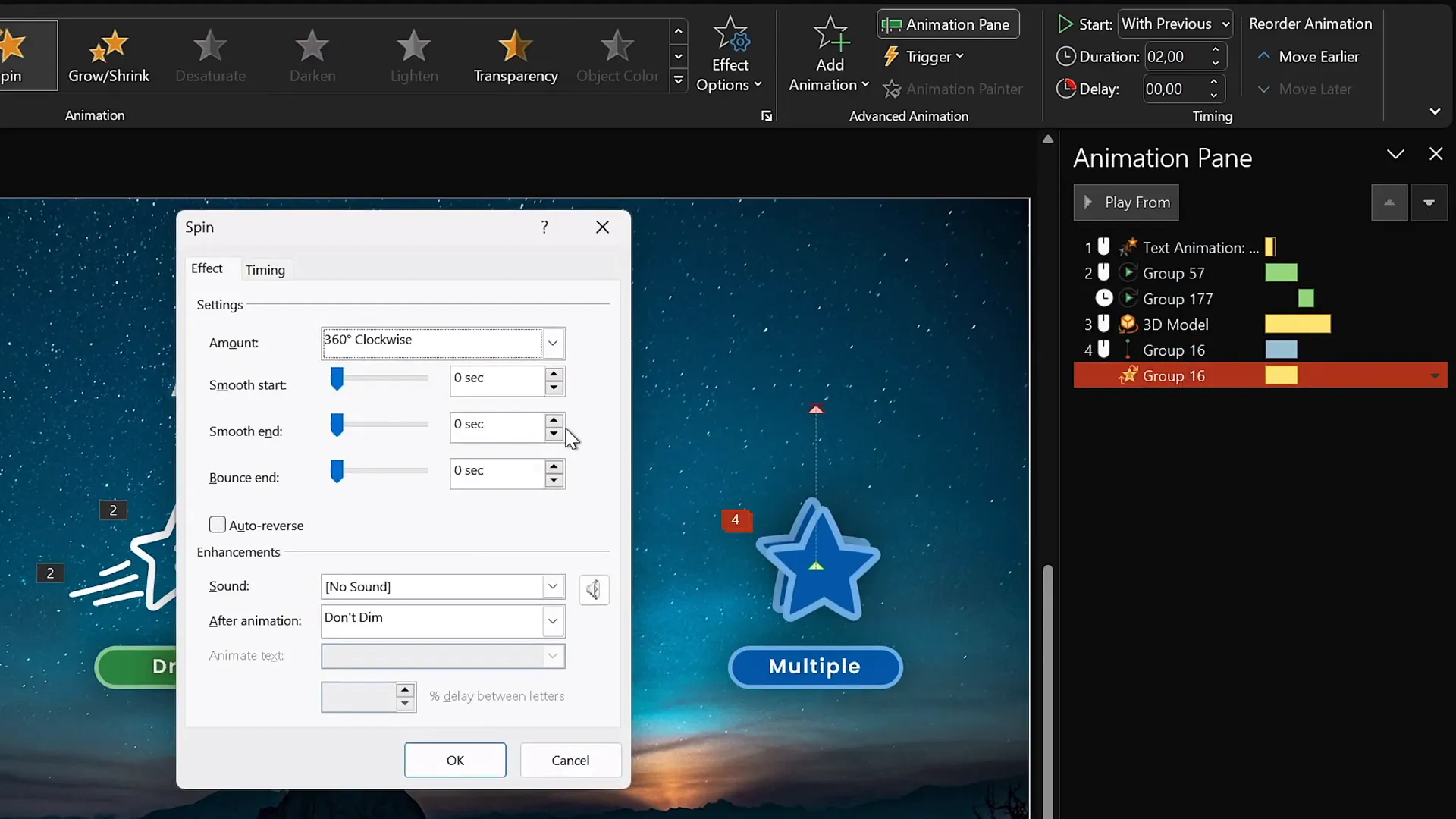
Frequently Asked Questions About PowerPoint Animations
Q1: What version of PowerPoint do I need to use advanced animations?
For the best experience, I recommend using PowerPoint 2019, PowerPoint 2021, or Microsoft 365 on Windows. The Windows version includes an advanced animation timeline that is extremely useful for creating complex animations. You can work on a Mac, but some advanced features may be limited.
Q2: Can I animate anything on a PowerPoint slide?
Yes! You can animate shapes, text boxes, pictures, videos, 3D models, and even drawings if your PowerPoint version supports the Draw feature.
Q3: How do I add multiple animations to the same object?
Use the Add Animation button in the Animations tab rather than clicking on a new animation directly. This ensures the new animation is added alongside existing ones instead of replacing them.
Q4: How can I control when animations start?
In the Animation Pane, you can set animations to start On Click, With Previous (simultaneously with the previous animation), or After Previous (automatically after the previous animation ends).
Q5: Are there any animations I should avoid?
Exciting animations like Pinwheel or other flashy effects can be fun but should be used sparingly. Overusing them can distract your audience and reduce the professionalism of your presentation.
Q6: How do I preview my animations?
Use the Preview button in the Animations tab or the Play From button in the Animation Pane to see how your animations will look during the presentation.
Q7: Can I animate 3D models in PowerPoint?
Yes! PowerPoint supports 3D models and offers specific entrance, emphasis, and exit animations for them, allowing you to add unique dynamic effects to your presentations.
Conclusion: Start Creating Incredible PowerPoint Animations Today
PowerPoint animations are a versatile and powerful way to make your presentations more engaging, dynamic, and professional. By understanding the four main types of animations and exploring additional methods like text animations, draw animations, 3D model animations, and custom multi-effect animations, you can unlock endless creative possibilities.
Remember, the key to mastery is practice and experimentation. Start with simple entrance and emphasis animations, then gradually build your skills with motion paths and multiple animations. Use the Animation Pane to control timing and sequence, and add smoothness to make your animations feel natural.
Whether you’re designing presentations for business, education, or personal projects, mastering PowerPoint animations will help you communicate your ideas clearly and captivate your audience.
So, what are you waiting for? Open PowerPoint, start animating, and create the incredible presentations you’ve always dreamed of!
Check out the full video: The Secret to INCREDIBLE PowerPoint Animations! 🤫✨








